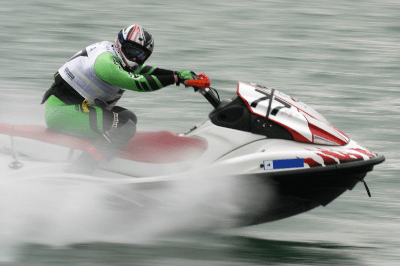What Is a Water Bike?

A Water Bike, also known as a Jet Ski, is one of the special small watercraft in Japan.
In English-speaking regions, it falls under the category of pleasure boats. The formal term in Japan is “water motorcycle.” Jet Ski is a registered trademark of Kawasaki, and Marine Jet is a registered trademark of Yamaha. In the United States, it is also referred to as Personal Watercraft (PWC).
While many people may think that Kawasaki’s Jet Ski was the first water bike, the Bombardier Sea-Doo, a single-seater sitting-type watercraft released by Bombardier Recreational Products (BRP) in 1968, is considered the first water bike.
Uses of Water Bike
Water bikes have diverse applications in leisure, sports, racing, and various other activities, taking advantage of their characteristics and functions.
Some specific use cases include:
- Free riding or touring without a set destination
- Racing on predefined courses to compete for speed
- Freestyle activities involving acrobatic maneuvers and scoring
- Towing water skis behind the water bike
- Fishing
- Coastal policing by law enforcement
- Rescue operations by military, private companies, etc.
While water bikes provide a convenient means of transportation, instances of enthusiasts disregarding etiquette and rules have been observed. This has led to reported cases of disrupting fishing grounds, collisions with beachgoers, and other accidents. Administrative measures include restricting navigation areas based on the Ship Officers and Small Ship Operators Act and regulations, enforcing laws against operating under the influence, and conducting safety training sessions to prevent accidents.
Principle of Water Bike
Water bikes operate by rotating the impeller inside a jet pump using an engine, drawing water from the jet intake located on the underside of the hull, and expelling it at high speed through the jet nozzle for forward propulsion. Water bikes use propulsive force to make turns, and simultaneous throttle and handlebar operations enable easy maneuvering.
The engines used in water bikes come in two types: 4-stroke and 2-stroke. 2-stroke engines, with a simpler structure that is lightweight and easy to maintain, were commonly adopted until around the early 2000s. However, due to environmental concerns related to burning oil and issues with noise, which make them subject to regulations, 4-stroke engines have become the mainstream.
Characteristics of Water Bike
Advantages
- The compact hull allows for choosing parking locations without restrictions. Additionally, even when stationary, it occupies less space than regular vessels, causing minimal disruption to traffic.
- Due to its relatively low price, it is easily accessible for purchase.
- Maintenance costs, including insurance, taxes, and inspection fees, are lower compared to other vessels.
- Maneuverable in narrow areas and narrow waterways.
- Easy spin turns with a small turning radius.
Disadvantages
- Since the body is not covered, the rider is directly exposed to impact in case of an accident.
- Incorrect operations may lead to sliding or heeling, resulting in a risk of falling into the water.
- Lower fuel efficiency during low-speed navigation compared to vessels with screw propulsion.
- Reduced visibility and a significant loss of comfort during rainy weather.
Types of Water Bikes
Water bikes are mainly divided into three types:
1. Standing Type
A single-seater water bike operated in a standing position. It requires a bit of skill to maintain balance but offers a high degree of freedom in driving, making it suitable for those who enjoy a sense of speed.
2. Runabout Type
A water bike that accommodates two to four people, allowing them to sit. Due to its large body, it is easy to balance and maneuver.
3. Sports Type
Designed for sports such as boat racing, this water bike is engineered for high speed. When used for regular purposes, it is recommended to choose either the standing or runabout type to avoid excessive speed.
Other Information on Water Bike
License Requirement for Operation
To operate a water bike, one must obtain the “Special Small Ship Operator License.” This license, required for driving water bikes, can be obtained by individuals aged 16 and above.
Even if someone holds the “First-Class Small Ship Operator License” or “Second-Class Small Ship Operator License,” which are mandatory for operating watercraft, they cannot operate a Jet Ski without obtaining the specific license for it.